Financial Management Report: Investment Appraisal and Dividend Policy
VerifiedAdded on 2023/06/10
|16
|3902
|304
Report
AI Summary
This financial management report delves into investment appraisal techniques, including Payback Period, Net Present Value (NPV), and Accounting Rate of Return (ARR), to evaluate project feasibility. The report provides detailed calculations for two projects, offering recommendations based on each method's outcomes. It also examines the merits and demerits of each appraisal technique. Furthermore, the report analyzes the valuation of Carport Plc, considering its dividend policy and the impact of a proposed change in dividend strategy. The report utilizes the dividend discount model to determine share price and discusses various theories surrounding dividend payments and their effect on market prices, concluding with a comprehensive overview of the financial implications.

FINANCIAL
MANAGEMENT
MANAGEMENT
Paraphrase This Document
Need a fresh take? Get an instant paraphrase of this document with our AI Paraphraser
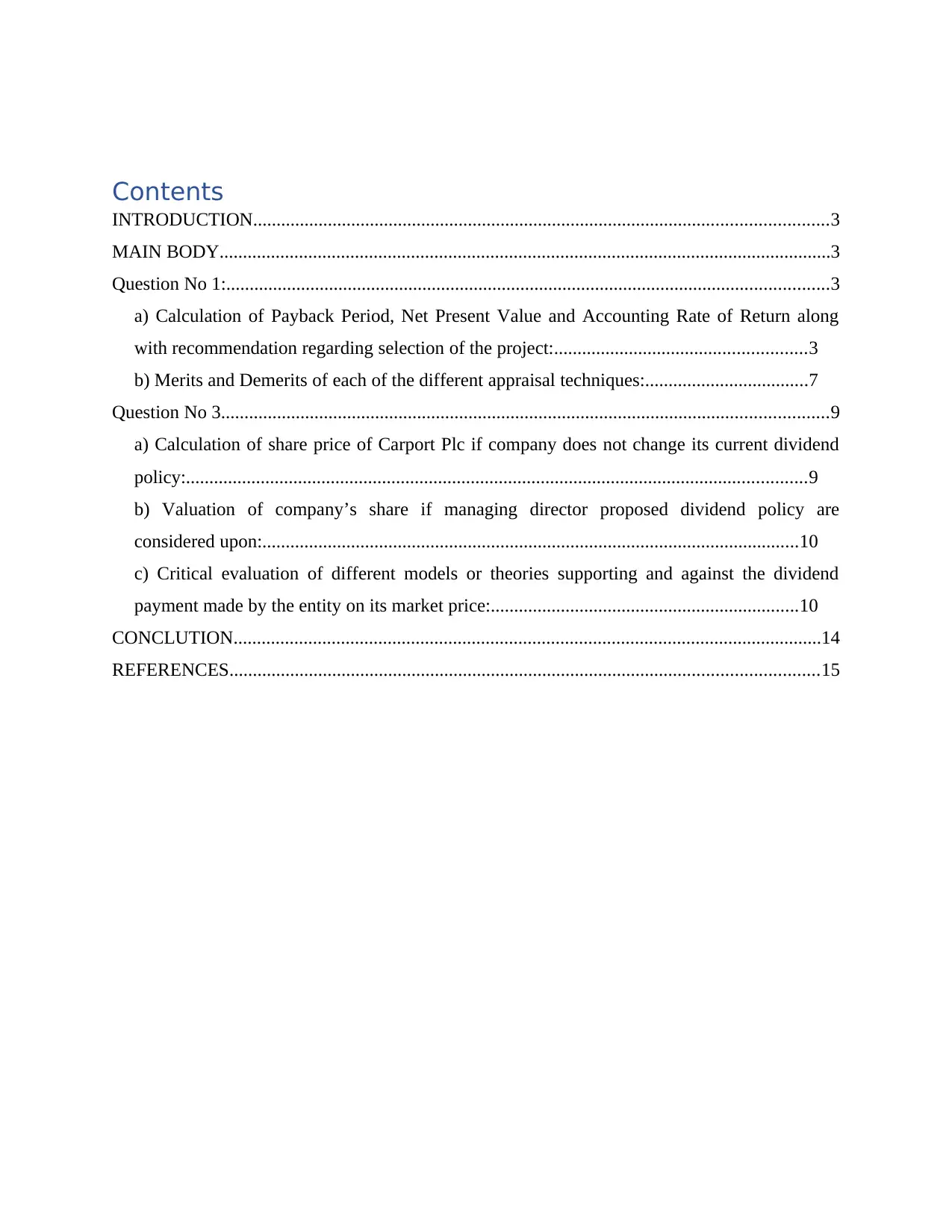
Contents
INTRODUCTION...........................................................................................................................3
MAIN BODY...................................................................................................................................3
Question No 1:.................................................................................................................................3
a) Calculation of Payback Period, Net Present Value and Accounting Rate of Return along
with recommendation regarding selection of the project:......................................................3
b) Merits and Demerits of each of the different appraisal techniques:...................................7
Question No 3..................................................................................................................................9
a) Calculation of share price of Carport Plc if company does not change its current dividend
policy:.....................................................................................................................................9
b) Valuation of company’s share if managing director proposed dividend policy are
considered upon:...................................................................................................................10
c) Critical evaluation of different models or theories supporting and against the dividend
payment made by the entity on its market price:..................................................................10
CONCLUTION..............................................................................................................................14
REFERENCES..............................................................................................................................15
INTRODUCTION...........................................................................................................................3
MAIN BODY...................................................................................................................................3
Question No 1:.................................................................................................................................3
a) Calculation of Payback Period, Net Present Value and Accounting Rate of Return along
with recommendation regarding selection of the project:......................................................3
b) Merits and Demerits of each of the different appraisal techniques:...................................7
Question No 3..................................................................................................................................9
a) Calculation of share price of Carport Plc if company does not change its current dividend
policy:.....................................................................................................................................9
b) Valuation of company’s share if managing director proposed dividend policy are
considered upon:...................................................................................................................10
c) Critical evaluation of different models or theories supporting and against the dividend
payment made by the entity on its market price:..................................................................10
CONCLUTION..............................................................................................................................14
REFERENCES..............................................................................................................................15
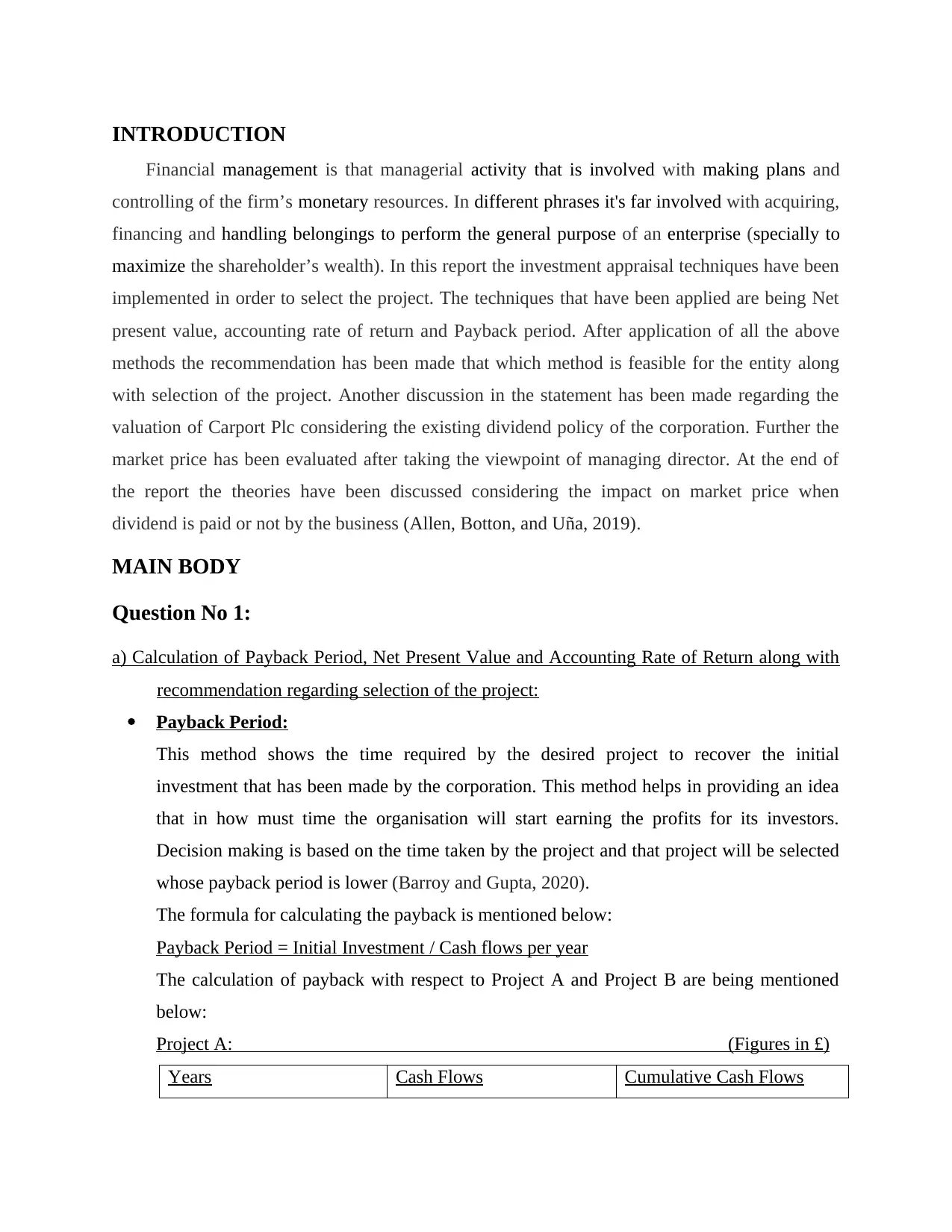
INTRODUCTION
Financial management is that managerial activity that is involved with making plans and
controlling of the firm’s monetary resources. In different phrases it's far involved with acquiring,
financing and handling belongings to perform the general purpose of an enterprise (specially to
maximize the shareholder’s wealth). In this report the investment appraisal techniques have been
implemented in order to select the project. The techniques that have been applied are being Net
present value, accounting rate of return and Payback period. After application of all the above
methods the recommendation has been made that which method is feasible for the entity along
with selection of the project. Another discussion in the statement has been made regarding the
valuation of Carport Plc considering the existing dividend policy of the corporation. Further the
market price has been evaluated after taking the viewpoint of managing director. At the end of
the report the theories have been discussed considering the impact on market price when
dividend is paid or not by the business (Allen, Botton, and Uña, 2019).
MAIN BODY
Question No 1:
a) Calculation of Payback Period, Net Present Value and Accounting Rate of Return along with
recommendation regarding selection of the project:
Payback Period:
This method shows the time required by the desired project to recover the initial
investment that has been made by the corporation. This method helps in providing an idea
that in how must time the organisation will start earning the profits for its investors.
Decision making is based on the time taken by the project and that project will be selected
whose payback period is lower (Barroy and Gupta, 2020).
The formula for calculating the payback is mentioned below:
Payback Period = Initial Investment / Cash flows per year
The calculation of payback with respect to Project A and Project B are being mentioned
below:
Project A: (Figures in £)
Years Cash Flows Cumulative Cash Flows
Financial management is that managerial activity that is involved with making plans and
controlling of the firm’s monetary resources. In different phrases it's far involved with acquiring,
financing and handling belongings to perform the general purpose of an enterprise (specially to
maximize the shareholder’s wealth). In this report the investment appraisal techniques have been
implemented in order to select the project. The techniques that have been applied are being Net
present value, accounting rate of return and Payback period. After application of all the above
methods the recommendation has been made that which method is feasible for the entity along
with selection of the project. Another discussion in the statement has been made regarding the
valuation of Carport Plc considering the existing dividend policy of the corporation. Further the
market price has been evaluated after taking the viewpoint of managing director. At the end of
the report the theories have been discussed considering the impact on market price when
dividend is paid or not by the business (Allen, Botton, and Uña, 2019).
MAIN BODY
Question No 1:
a) Calculation of Payback Period, Net Present Value and Accounting Rate of Return along with
recommendation regarding selection of the project:
Payback Period:
This method shows the time required by the desired project to recover the initial
investment that has been made by the corporation. This method helps in providing an idea
that in how must time the organisation will start earning the profits for its investors.
Decision making is based on the time taken by the project and that project will be selected
whose payback period is lower (Barroy and Gupta, 2020).
The formula for calculating the payback is mentioned below:
Payback Period = Initial Investment / Cash flows per year
The calculation of payback with respect to Project A and Project B are being mentioned
below:
Project A: (Figures in £)
Years Cash Flows Cumulative Cash Flows
⊘ This is a preview!⊘
Do you want full access?
Subscribe today to unlock all pages.

Trusted by 1+ million students worldwide
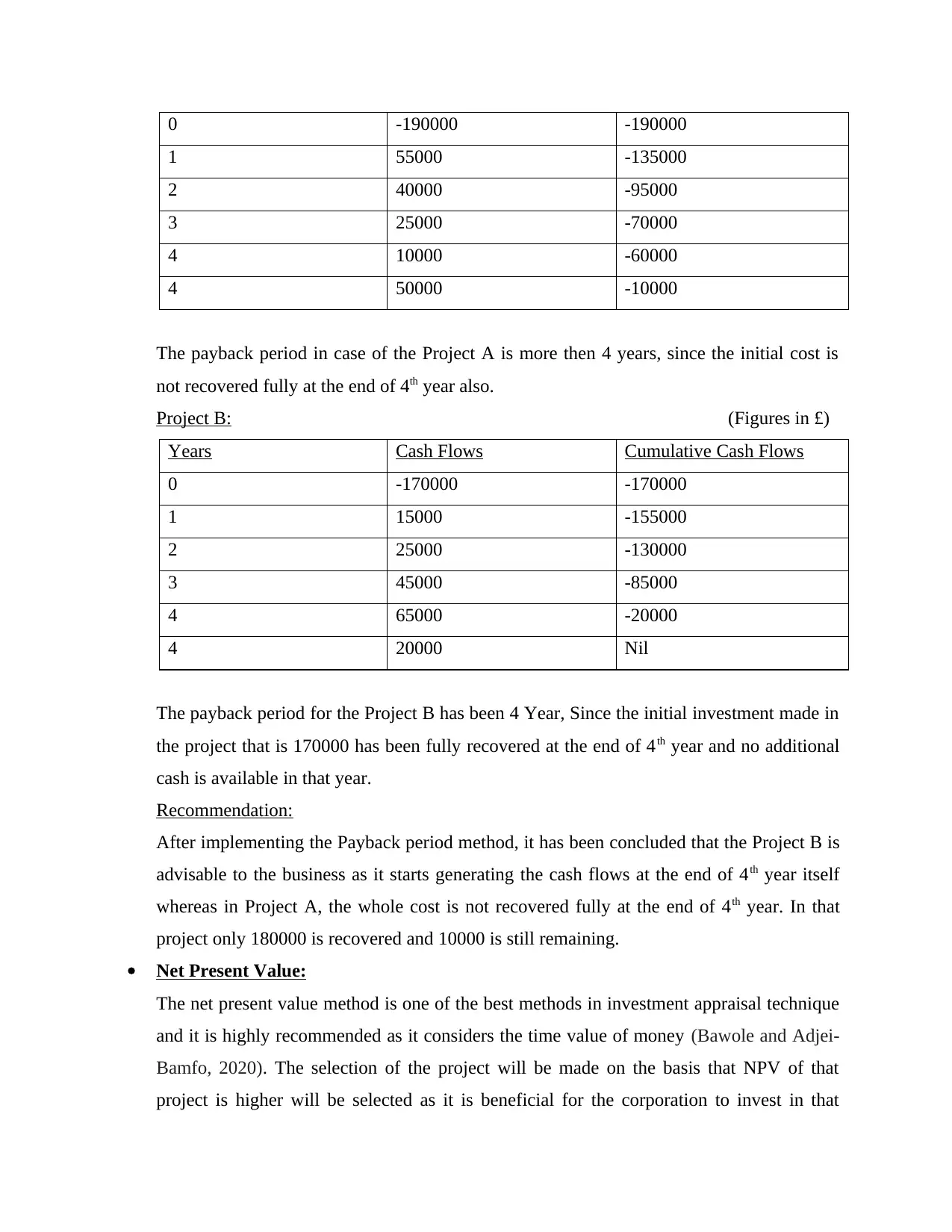
0 -190000 -190000
1 55000 -135000
2 40000 -95000
3 25000 -70000
4 10000 -60000
4 50000 -10000
The payback period in case of the Project A is more then 4 years, since the initial cost is
not recovered fully at the end of 4th year also.
Project B: (Figures in £)
Years Cash Flows Cumulative Cash Flows
0 -170000 -170000
1 15000 -155000
2 25000 -130000
3 45000 -85000
4 65000 -20000
4 20000 Nil
The payback period for the Project B has been 4 Year, Since the initial investment made in
the project that is 170000 has been fully recovered at the end of 4th year and no additional
cash is available in that year.
Recommendation:
After implementing the Payback period method, it has been concluded that the Project B is
advisable to the business as it starts generating the cash flows at the end of 4th year itself
whereas in Project A, the whole cost is not recovered fully at the end of 4th year. In that
project only 180000 is recovered and 10000 is still remaining.
Net Present Value:
The net present value method is one of the best methods in investment appraisal technique
and it is highly recommended as it considers the time value of money (Bawole and Adjei-
Bamfo, 2020). The selection of the project will be made on the basis that NPV of that
project is higher will be selected as it is beneficial for the corporation to invest in that
1 55000 -135000
2 40000 -95000
3 25000 -70000
4 10000 -60000
4 50000 -10000
The payback period in case of the Project A is more then 4 years, since the initial cost is
not recovered fully at the end of 4th year also.
Project B: (Figures in £)
Years Cash Flows Cumulative Cash Flows
0 -170000 -170000
1 15000 -155000
2 25000 -130000
3 45000 -85000
4 65000 -20000
4 20000 Nil
The payback period for the Project B has been 4 Year, Since the initial investment made in
the project that is 170000 has been fully recovered at the end of 4th year and no additional
cash is available in that year.
Recommendation:
After implementing the Payback period method, it has been concluded that the Project B is
advisable to the business as it starts generating the cash flows at the end of 4th year itself
whereas in Project A, the whole cost is not recovered fully at the end of 4th year. In that
project only 180000 is recovered and 10000 is still remaining.
Net Present Value:
The net present value method is one of the best methods in investment appraisal technique
and it is highly recommended as it considers the time value of money (Bawole and Adjei-
Bamfo, 2020). The selection of the project will be made on the basis that NPV of that
project is higher will be selected as it is beneficial for the corporation to invest in that
Paraphrase This Document
Need a fresh take? Get an instant paraphrase of this document with our AI Paraphraser
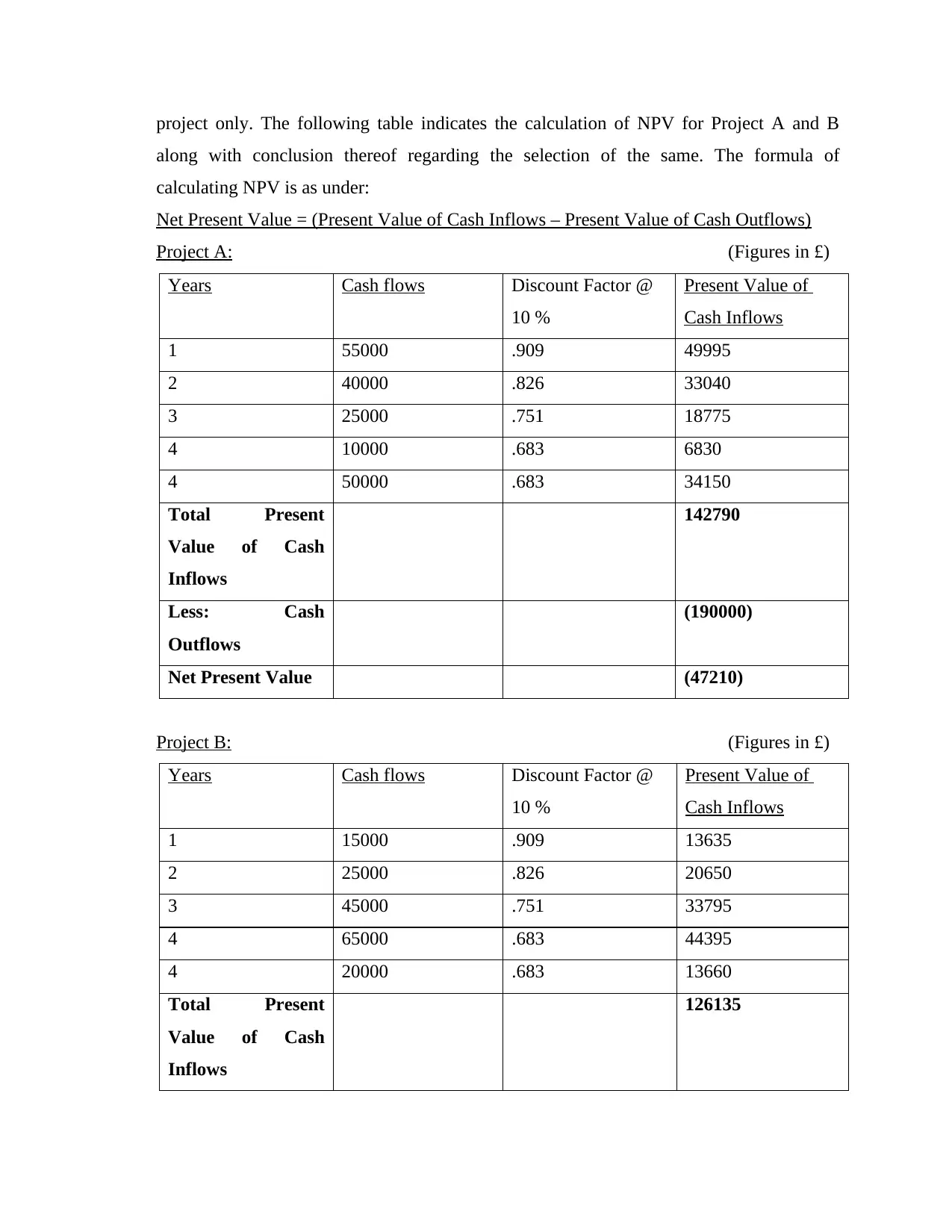
project only. The following table indicates the calculation of NPV for Project A and B
along with conclusion thereof regarding the selection of the same. The formula of
calculating NPV is as under:
Net Present Value = (Present Value of Cash Inflows – Present Value of Cash Outflows)
Project A: (Figures in £)
Years Cash flows Discount Factor @
10 %
Present Value of
Cash Inflows
1 55000 .909 49995
2 40000 .826 33040
3 25000 .751 18775
4 10000 .683 6830
4 50000 .683 34150
Total Present
Value of Cash
Inflows
142790
Less: Cash
Outflows
(190000)
Net Present Value (47210)
Project B: (Figures in £)
Years Cash flows Discount Factor @
10 %
Present Value of
Cash Inflows
1 15000 .909 13635
2 25000 .826 20650
3 45000 .751 33795
4 65000 .683 44395
4 20000 .683 13660
Total Present
Value of Cash
Inflows
126135
along with conclusion thereof regarding the selection of the same. The formula of
calculating NPV is as under:
Net Present Value = (Present Value of Cash Inflows – Present Value of Cash Outflows)
Project A: (Figures in £)
Years Cash flows Discount Factor @
10 %
Present Value of
Cash Inflows
1 55000 .909 49995
2 40000 .826 33040
3 25000 .751 18775
4 10000 .683 6830
4 50000 .683 34150
Total Present
Value of Cash
Inflows
142790
Less: Cash
Outflows
(190000)
Net Present Value (47210)
Project B: (Figures in £)
Years Cash flows Discount Factor @
10 %
Present Value of
Cash Inflows
1 15000 .909 13635
2 25000 .826 20650
3 45000 .751 33795
4 65000 .683 44395
4 20000 .683 13660
Total Present
Value of Cash
Inflows
126135
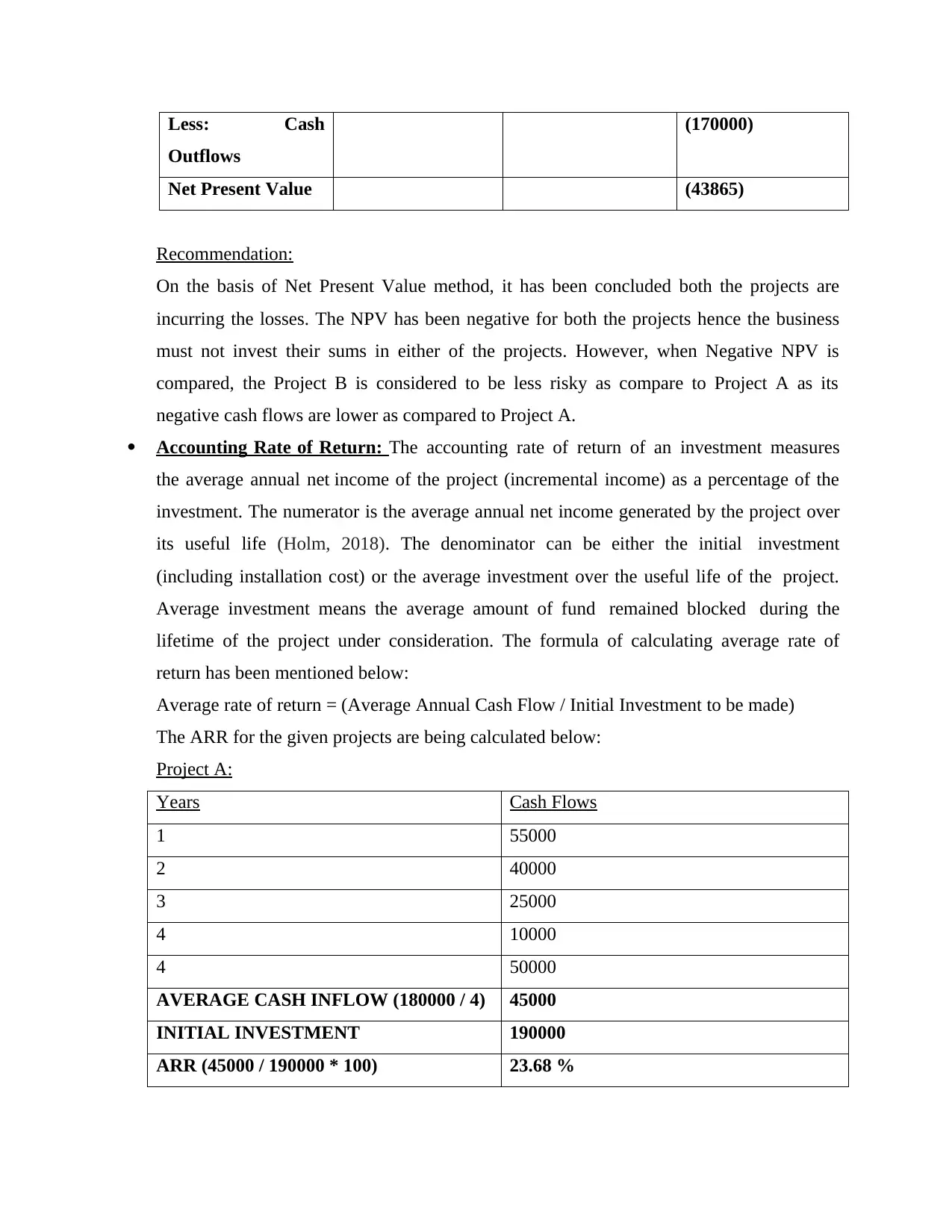
Less: Cash
Outflows
(170000)
Net Present Value (43865)
Recommendation:
On the basis of Net Present Value method, it has been concluded both the projects are
incurring the losses. The NPV has been negative for both the projects hence the business
must not invest their sums in either of the projects. However, when Negative NPV is
compared, the Project B is considered to be less risky as compare to Project A as its
negative cash flows are lower as compared to Project A.
Accounting Rate of Return: The accounting rate of return of an investment measures
the average annual net income of the project (incremental income) as a percentage of the
investment. The numerator is the average annual net income generated by the project over
its useful life (Holm, 2018). The denominator can be either the initial investment
(including installation cost) or the average investment over the useful life of the project.
Average investment means the average amount of fund remained blocked during the
lifetime of the project under consideration. The formula of calculating average rate of
return has been mentioned below:
Average rate of return = (Average Annual Cash Flow / Initial Investment to be made)
The ARR for the given projects are being calculated below:
Project A:
Years Cash Flows
1 55000
2 40000
3 25000
4 10000
4 50000
AVERAGE CASH INFLOW (180000 / 4) 45000
INITIAL INVESTMENT 190000
ARR (45000 / 190000 * 100) 23.68 %
Outflows
(170000)
Net Present Value (43865)
Recommendation:
On the basis of Net Present Value method, it has been concluded both the projects are
incurring the losses. The NPV has been negative for both the projects hence the business
must not invest their sums in either of the projects. However, when Negative NPV is
compared, the Project B is considered to be less risky as compare to Project A as its
negative cash flows are lower as compared to Project A.
Accounting Rate of Return: The accounting rate of return of an investment measures
the average annual net income of the project (incremental income) as a percentage of the
investment. The numerator is the average annual net income generated by the project over
its useful life (Holm, 2018). The denominator can be either the initial investment
(including installation cost) or the average investment over the useful life of the project.
Average investment means the average amount of fund remained blocked during the
lifetime of the project under consideration. The formula of calculating average rate of
return has been mentioned below:
Average rate of return = (Average Annual Cash Flow / Initial Investment to be made)
The ARR for the given projects are being calculated below:
Project A:
Years Cash Flows
1 55000
2 40000
3 25000
4 10000
4 50000
AVERAGE CASH INFLOW (180000 / 4) 45000
INITIAL INVESTMENT 190000
ARR (45000 / 190000 * 100) 23.68 %
⊘ This is a preview!⊘
Do you want full access?
Subscribe today to unlock all pages.

Trusted by 1+ million students worldwide
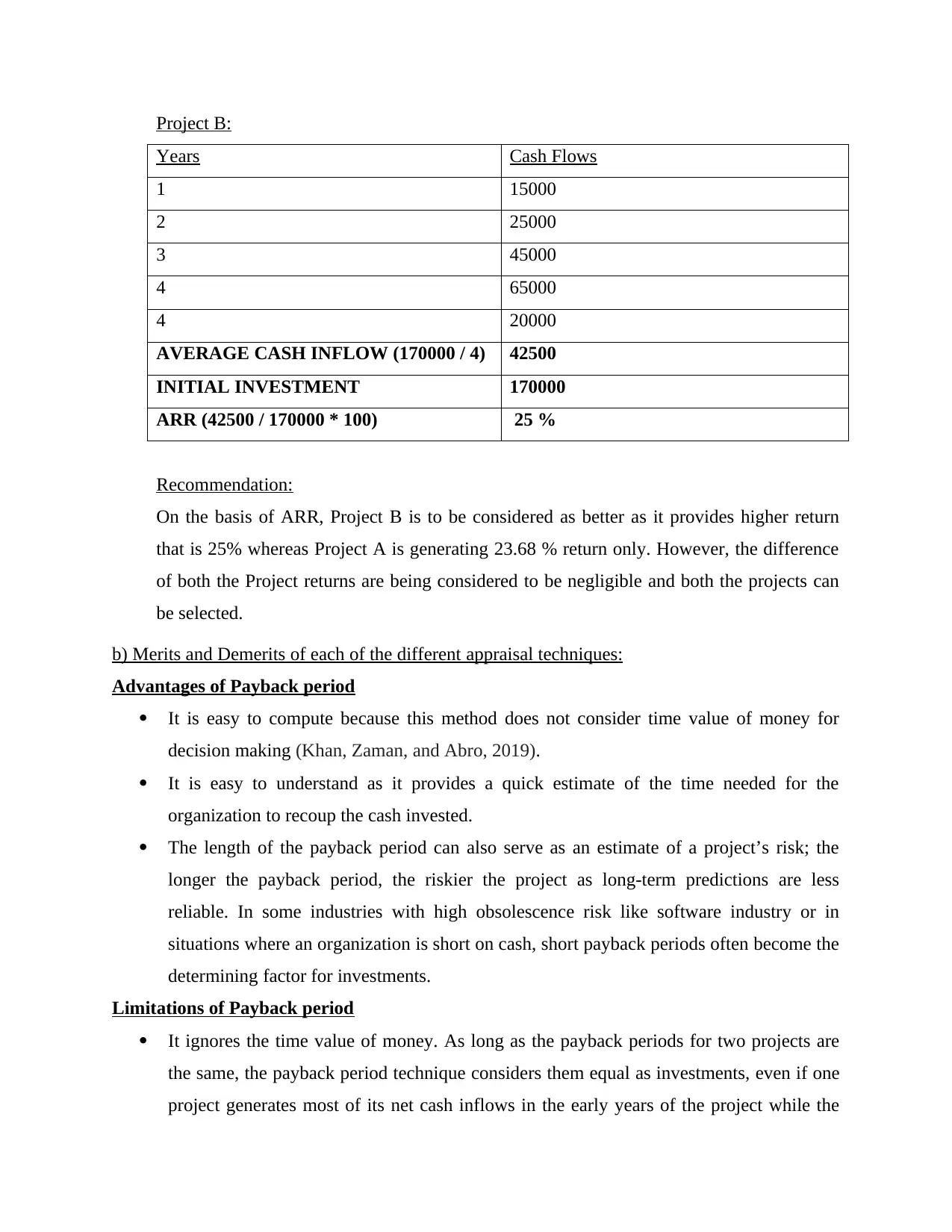
Project B:
Years Cash Flows
1 15000
2 25000
3 45000
4 65000
4 20000
AVERAGE CASH INFLOW (170000 / 4) 42500
INITIAL INVESTMENT 170000
ARR (42500 / 170000 * 100) 25 %
Recommendation:
On the basis of ARR, Project B is to be considered as better as it provides higher return
that is 25% whereas Project A is generating 23.68 % return only. However, the difference
of both the Project returns are being considered to be negligible and both the projects can
be selected.
b) Merits and Demerits of each of the different appraisal techniques:
Advantages of Payback period
It is easy to compute because this method does not consider time value of money for
decision making (Khan, Zaman, and Abro, 2019).
It is easy to understand as it provides a quick estimate of the time needed for the
organization to recoup the cash invested.
The length of the payback period can also serve as an estimate of a project’s risk; the
longer the payback period, the riskier the project as long-term predictions are less
reliable. In some industries with high obsolescence risk like software industry or in
situations where an organization is short on cash, short payback periods often become the
determining factor for investments.
Limitations of Payback period
It ignores the time value of money. As long as the payback periods for two projects are
the same, the payback period technique considers them equal as investments, even if one
project generates most of its net cash inflows in the early years of the project while the
Years Cash Flows
1 15000
2 25000
3 45000
4 65000
4 20000
AVERAGE CASH INFLOW (170000 / 4) 42500
INITIAL INVESTMENT 170000
ARR (42500 / 170000 * 100) 25 %
Recommendation:
On the basis of ARR, Project B is to be considered as better as it provides higher return
that is 25% whereas Project A is generating 23.68 % return only. However, the difference
of both the Project returns are being considered to be negligible and both the projects can
be selected.
b) Merits and Demerits of each of the different appraisal techniques:
Advantages of Payback period
It is easy to compute because this method does not consider time value of money for
decision making (Khan, Zaman, and Abro, 2019).
It is easy to understand as it provides a quick estimate of the time needed for the
organization to recoup the cash invested.
The length of the payback period can also serve as an estimate of a project’s risk; the
longer the payback period, the riskier the project as long-term predictions are less
reliable. In some industries with high obsolescence risk like software industry or in
situations where an organization is short on cash, short payback periods often become the
determining factor for investments.
Limitations of Payback period
It ignores the time value of money. As long as the payback periods for two projects are
the same, the payback period technique considers them equal as investments, even if one
project generates most of its net cash inflows in the early years of the project while the
Paraphrase This Document
Need a fresh take? Get an instant paraphrase of this document with our AI Paraphraser

other project generates most of its net cash inflows in the latter years of the payback
period (Kumar and Nagaraju, 2018).
A second limitation of this technique is its failure to consider an investment’s total
profitability; it only considers cash inflows up-to the period in which initial investment is
fully recovered and ignores cash flows after the payback period.
Payback technique places much emphasis on short payback periods thereby ignoring
long-term projects.
Advantages of ARR
This technique uses readily available data that is routinely generated for financial reports
and does not require any special procedures to generate data.
This method may also mirror the method used to evaluate performance on the operating
results of an investment and management performance. Using the same procedure in both
decision-making and performance evaluation ensures consistency (Oleghe, 2019).
Calculation of the accounting rate of return method considers all net incomes over the
entire life of the project and provides a measure of the investment’s profitability.
Limitations of ARR
The accounting rate of return technique, like the payback period technique, ignores the
time value of money and considers the value of all cash flows to be equal.
The technique uses accounting numbers that are dependent on the organization’s choice
of accounting procedures, and different accounting procedures, e.g., depreciation
methods, can lead to substantially different amounts for an investment’s net income and
book values.
The method uses net income rather than cash flows; while net income is a useful measure
of profitability, the net cash flow is a better measure of an investment’s performance.
Furthermore, inclusion of only the book value of the invested asset ignores the fact that a
project can require commitments of working capital and other outlays that are not
included in the book value of the project (Pinckney, Cohen, and Leonard, 2019).
Advantages of NPV
NPV method takes into account the time value of money that provide more accurate
results for the enterprise.
period (Kumar and Nagaraju, 2018).
A second limitation of this technique is its failure to consider an investment’s total
profitability; it only considers cash inflows up-to the period in which initial investment is
fully recovered and ignores cash flows after the payback period.
Payback technique places much emphasis on short payback periods thereby ignoring
long-term projects.
Advantages of ARR
This technique uses readily available data that is routinely generated for financial reports
and does not require any special procedures to generate data.
This method may also mirror the method used to evaluate performance on the operating
results of an investment and management performance. Using the same procedure in both
decision-making and performance evaluation ensures consistency (Oleghe, 2019).
Calculation of the accounting rate of return method considers all net incomes over the
entire life of the project and provides a measure of the investment’s profitability.
Limitations of ARR
The accounting rate of return technique, like the payback period technique, ignores the
time value of money and considers the value of all cash flows to be equal.
The technique uses accounting numbers that are dependent on the organization’s choice
of accounting procedures, and different accounting procedures, e.g., depreciation
methods, can lead to substantially different amounts for an investment’s net income and
book values.
The method uses net income rather than cash flows; while net income is a useful measure
of profitability, the net cash flow is a better measure of an investment’s performance.
Furthermore, inclusion of only the book value of the invested asset ignores the fact that a
project can require commitments of working capital and other outlays that are not
included in the book value of the project (Pinckney, Cohen, and Leonard, 2019).
Advantages of NPV
NPV method takes into account the time value of money that provide more accurate
results for the enterprise.
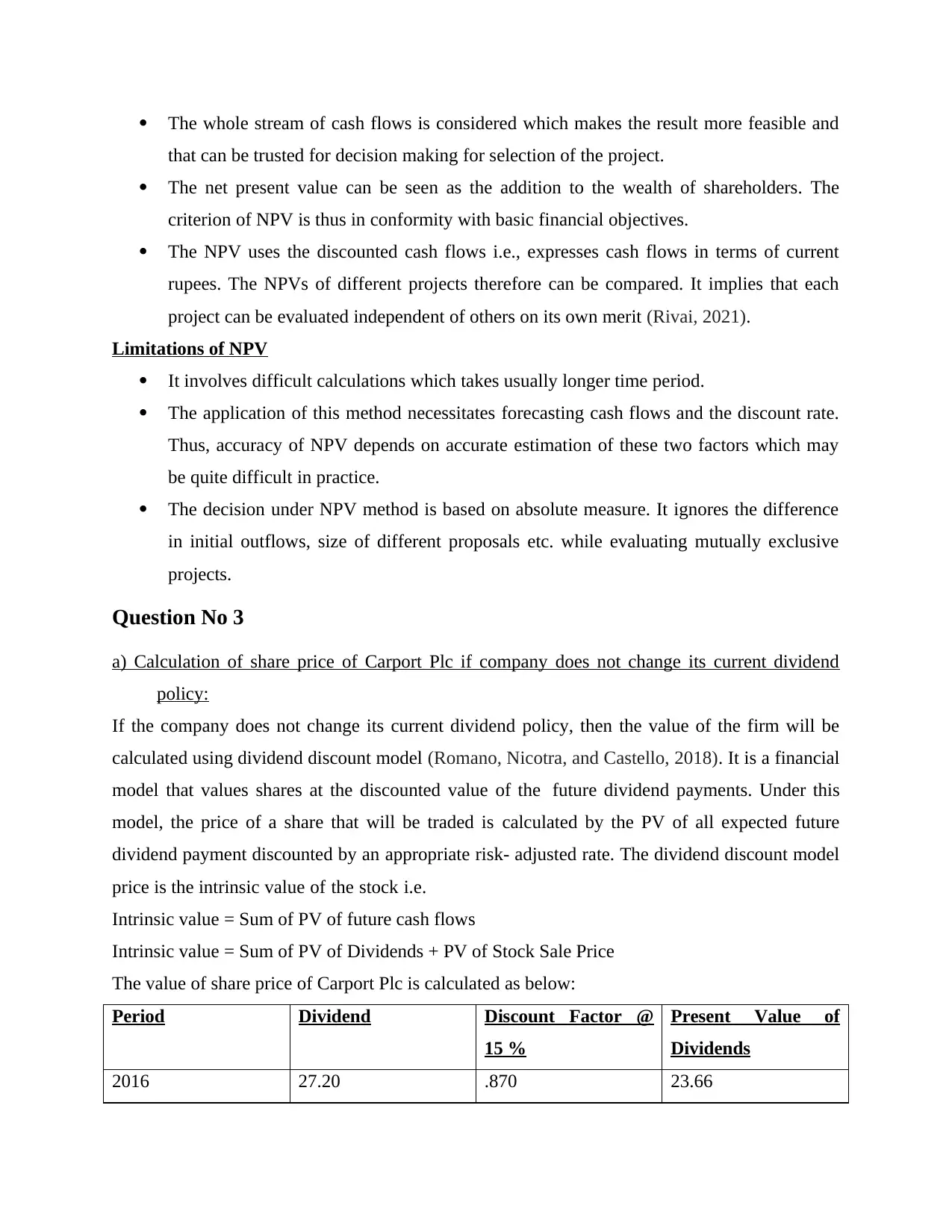
The whole stream of cash flows is considered which makes the result more feasible and
that can be trusted for decision making for selection of the project.
The net present value can be seen as the addition to the wealth of shareholders. The
criterion of NPV is thus in conformity with basic financial objectives.
The NPV uses the discounted cash flows i.e., expresses cash flows in terms of current
rupees. The NPVs of different projects therefore can be compared. It implies that each
project can be evaluated independent of others on its own merit (Rivai, 2021).
Limitations of NPV
It involves difficult calculations which takes usually longer time period.
The application of this method necessitates forecasting cash flows and the discount rate.
Thus, accuracy of NPV depends on accurate estimation of these two factors which may
be quite difficult in practice.
The decision under NPV method is based on absolute measure. It ignores the difference
in initial outflows, size of different proposals etc. while evaluating mutually exclusive
projects.
Question No 3
a) Calculation of share price of Carport Plc if company does not change its current dividend
policy:
If the company does not change its current dividend policy, then the value of the firm will be
calculated using dividend discount model (Romano, Nicotra, and Castello, 2018). It is a financial
model that values shares at the discounted value of the future dividend payments. Under this
model, the price of a share that will be traded is calculated by the PV of all expected future
dividend payment discounted by an appropriate risk- adjusted rate. The dividend discount model
price is the intrinsic value of the stock i.e.
Intrinsic value = Sum of PV of future cash flows
Intrinsic value = Sum of PV of Dividends + PV of Stock Sale Price
The value of share price of Carport Plc is calculated as below:
Period Dividend Discount Factor @
15 %
Present Value of
Dividends
2016 27.20 .870 23.66
that can be trusted for decision making for selection of the project.
The net present value can be seen as the addition to the wealth of shareholders. The
criterion of NPV is thus in conformity with basic financial objectives.
The NPV uses the discounted cash flows i.e., expresses cash flows in terms of current
rupees. The NPVs of different projects therefore can be compared. It implies that each
project can be evaluated independent of others on its own merit (Rivai, 2021).
Limitations of NPV
It involves difficult calculations which takes usually longer time period.
The application of this method necessitates forecasting cash flows and the discount rate.
Thus, accuracy of NPV depends on accurate estimation of these two factors which may
be quite difficult in practice.
The decision under NPV method is based on absolute measure. It ignores the difference
in initial outflows, size of different proposals etc. while evaluating mutually exclusive
projects.
Question No 3
a) Calculation of share price of Carport Plc if company does not change its current dividend
policy:
If the company does not change its current dividend policy, then the value of the firm will be
calculated using dividend discount model (Romano, Nicotra, and Castello, 2018). It is a financial
model that values shares at the discounted value of the future dividend payments. Under this
model, the price of a share that will be traded is calculated by the PV of all expected future
dividend payment discounted by an appropriate risk- adjusted rate. The dividend discount model
price is the intrinsic value of the stock i.e.
Intrinsic value = Sum of PV of future cash flows
Intrinsic value = Sum of PV of Dividends + PV of Stock Sale Price
The value of share price of Carport Plc is calculated as below:
Period Dividend Discount Factor @
15 %
Present Value of
Dividends
2016 27.20 .870 23.66
⊘ This is a preview!⊘
Do you want full access?
Subscribe today to unlock all pages.

Trusted by 1+ million students worldwide
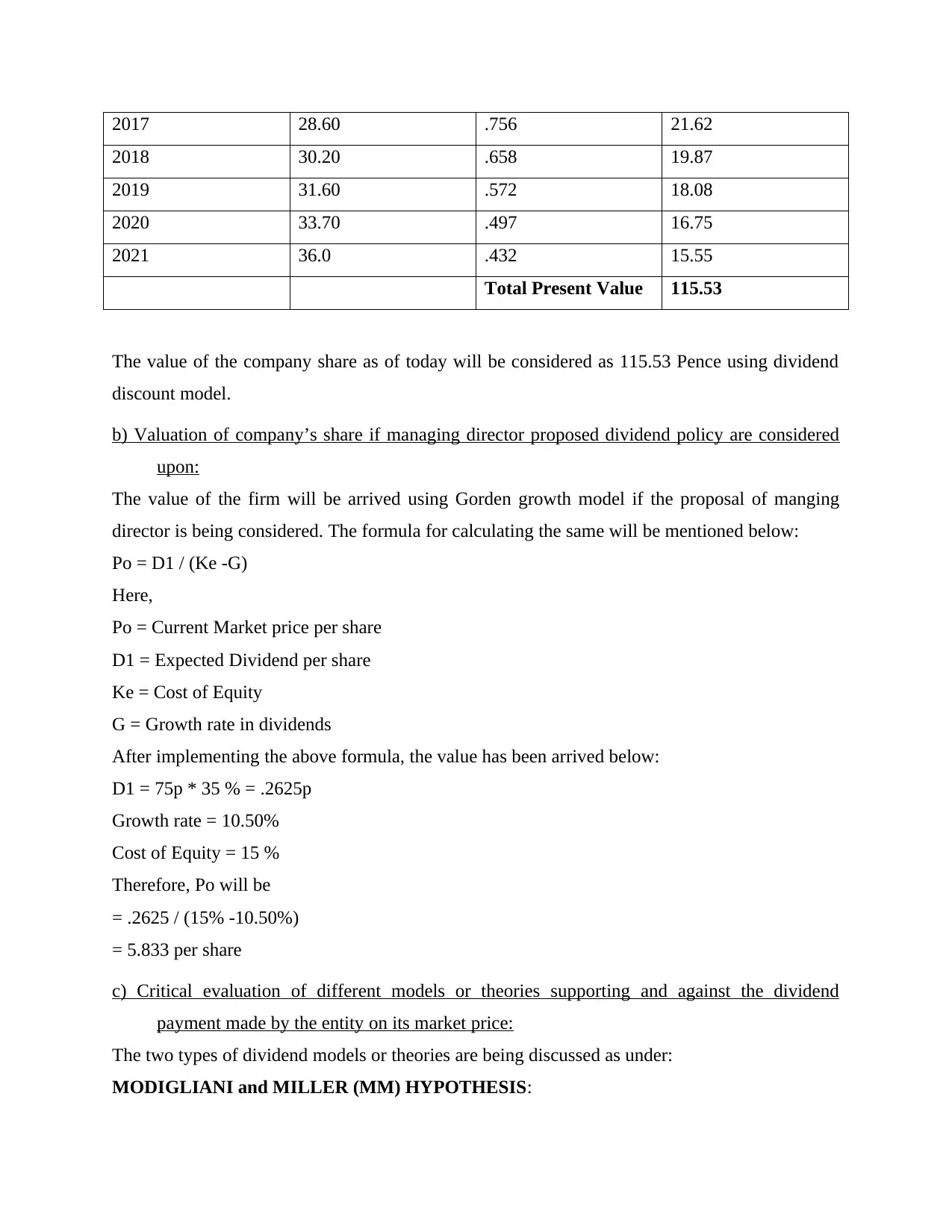
2017 28.60 .756 21.62
2018 30.20 .658 19.87
2019 31.60 .572 18.08
2020 33.70 .497 16.75
2021 36.0 .432 15.55
Total Present Value 115.53
The value of the company share as of today will be considered as 115.53 Pence using dividend
discount model.
b) Valuation of company’s share if managing director proposed dividend policy are considered
upon:
The value of the firm will be arrived using Gorden growth model if the proposal of manging
director is being considered. The formula for calculating the same will be mentioned below:
Po = D1 / (Ke -G)
Here,
Po = Current Market price per share
D1 = Expected Dividend per share
Ke = Cost of Equity
G = Growth rate in dividends
After implementing the above formula, the value has been arrived below:
D1 = 75p * 35 % = .2625p
Growth rate = 10.50%
Cost of Equity = 15 %
Therefore, Po will be
= .2625 / (15% -10.50%)
= 5.833 per share
c) Critical evaluation of different models or theories supporting and against the dividend
payment made by the entity on its market price:
The two types of dividend models or theories are being discussed as under:
MODIGLIANI and MILLER (MM) HYPOTHESIS:
2018 30.20 .658 19.87
2019 31.60 .572 18.08
2020 33.70 .497 16.75
2021 36.0 .432 15.55
Total Present Value 115.53
The value of the company share as of today will be considered as 115.53 Pence using dividend
discount model.
b) Valuation of company’s share if managing director proposed dividend policy are considered
upon:
The value of the firm will be arrived using Gorden growth model if the proposal of manging
director is being considered. The formula for calculating the same will be mentioned below:
Po = D1 / (Ke -G)
Here,
Po = Current Market price per share
D1 = Expected Dividend per share
Ke = Cost of Equity
G = Growth rate in dividends
After implementing the above formula, the value has been arrived below:
D1 = 75p * 35 % = .2625p
Growth rate = 10.50%
Cost of Equity = 15 %
Therefore, Po will be
= .2625 / (15% -10.50%)
= 5.833 per share
c) Critical evaluation of different models or theories supporting and against the dividend
payment made by the entity on its market price:
The two types of dividend models or theories are being discussed as under:
MODIGLIANI and MILLER (MM) HYPOTHESIS:
Paraphrase This Document
Need a fresh take? Get an instant paraphrase of this document with our AI Paraphraser
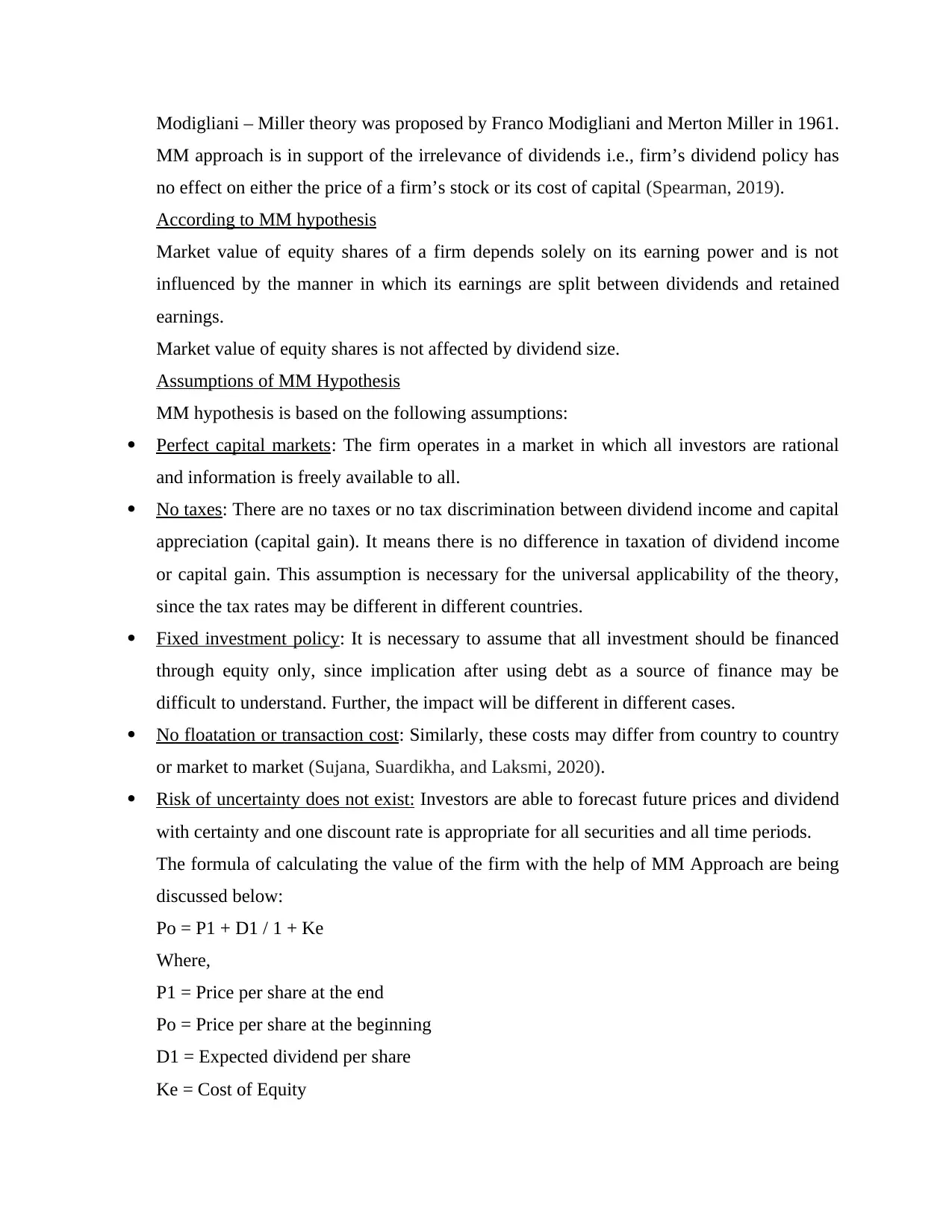
Modigliani – Miller theory was proposed by Franco Modigliani and Merton Miller in 1961.
MM approach is in support of the irrelevance of dividends i.e., firm’s dividend policy has
no effect on either the price of a firm’s stock or its cost of capital (Spearman, 2019).
According to MM hypothesis
Market value of equity shares of a firm depends solely on its earning power and is not
influenced by the manner in which its earnings are split between dividends and retained
earnings.
Market value of equity shares is not affected by dividend size.
Assumptions of MM Hypothesis
MM hypothesis is based on the following assumptions:
Perfect capital markets: The firm operates in a market in which all investors are rational
and information is freely available to all.
No taxes: There are no taxes or no tax discrimination between dividend income and capital
appreciation (capital gain). It means there is no difference in taxation of dividend income
or capital gain. This assumption is necessary for the universal applicability of the theory,
since the tax rates may be different in different countries.
Fixed investment policy: It is necessary to assume that all investment should be financed
through equity only, since implication after using debt as a source of finance may be
difficult to understand. Further, the impact will be different in different cases.
No floatation or transaction cost: Similarly, these costs may differ from country to country
or market to market (Sujana, Suardikha, and Laksmi, 2020).
Risk of uncertainty does not exist: Investors are able to forecast future prices and dividend
with certainty and one discount rate is appropriate for all securities and all time periods.
The formula of calculating the value of the firm with the help of MM Approach are being
discussed below:
Po = P1 + D1 / 1 + Ke
Where,
P1 = Price per share at the end
Po = Price per share at the beginning
D1 = Expected dividend per share
Ke = Cost of Equity
MM approach is in support of the irrelevance of dividends i.e., firm’s dividend policy has
no effect on either the price of a firm’s stock or its cost of capital (Spearman, 2019).
According to MM hypothesis
Market value of equity shares of a firm depends solely on its earning power and is not
influenced by the manner in which its earnings are split between dividends and retained
earnings.
Market value of equity shares is not affected by dividend size.
Assumptions of MM Hypothesis
MM hypothesis is based on the following assumptions:
Perfect capital markets: The firm operates in a market in which all investors are rational
and information is freely available to all.
No taxes: There are no taxes or no tax discrimination between dividend income and capital
appreciation (capital gain). It means there is no difference in taxation of dividend income
or capital gain. This assumption is necessary for the universal applicability of the theory,
since the tax rates may be different in different countries.
Fixed investment policy: It is necessary to assume that all investment should be financed
through equity only, since implication after using debt as a source of finance may be
difficult to understand. Further, the impact will be different in different cases.
No floatation or transaction cost: Similarly, these costs may differ from country to country
or market to market (Sujana, Suardikha, and Laksmi, 2020).
Risk of uncertainty does not exist: Investors are able to forecast future prices and dividend
with certainty and one discount rate is appropriate for all securities and all time periods.
The formula of calculating the value of the firm with the help of MM Approach are being
discussed below:
Po = P1 + D1 / 1 + Ke
Where,
P1 = Price per share at the end
Po = Price per share at the beginning
D1 = Expected dividend per share
Ke = Cost of Equity
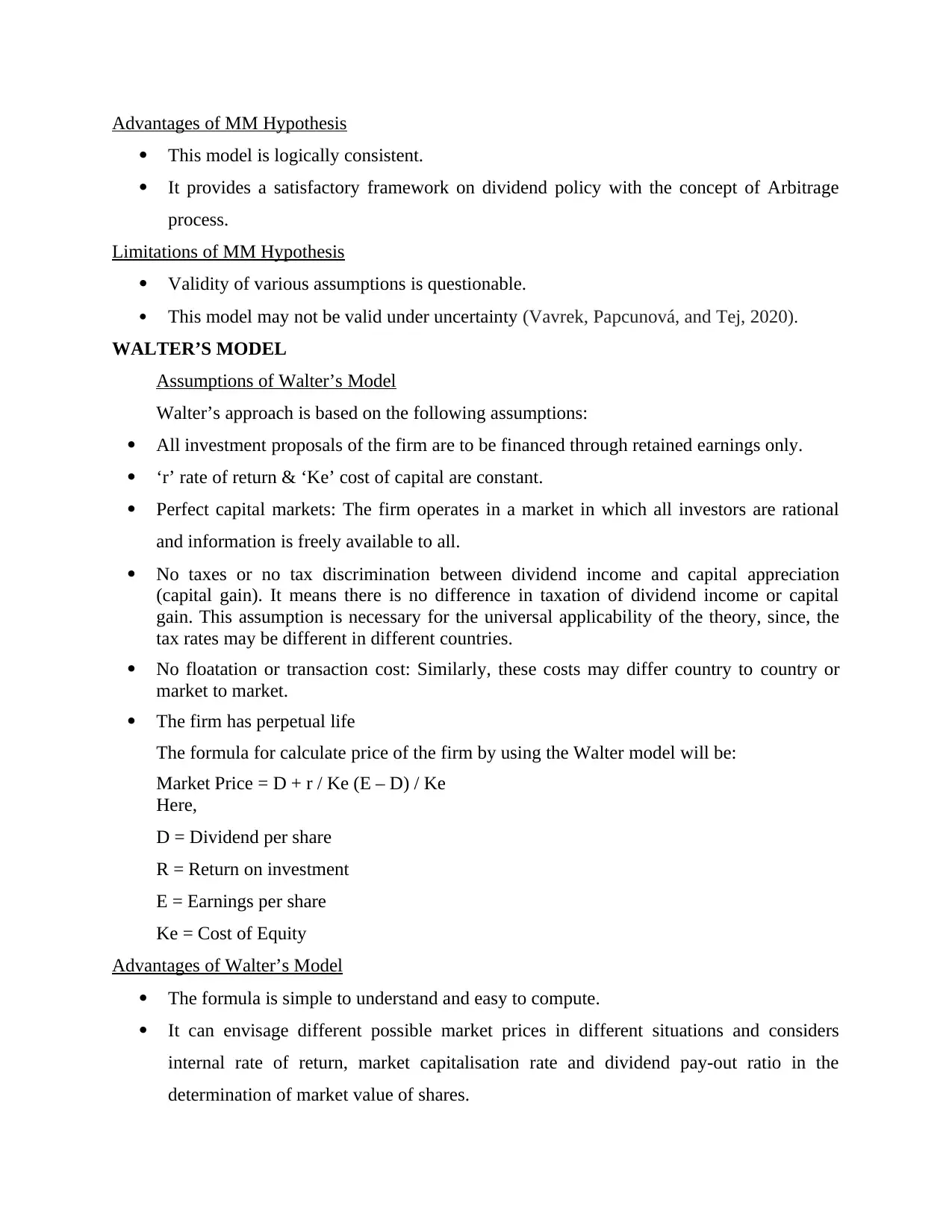
Advantages of MM Hypothesis
This model is logically consistent.
It provides a satisfactory framework on dividend policy with the concept of Arbitrage
process.
Limitations of MM Hypothesis
Validity of various assumptions is questionable.
This model may not be valid under uncertainty (Vavrek, Papcunová, and Tej, 2020).
WALTER’S MODEL
Assumptions of Walter’s Model
Walter’s approach is based on the following assumptions:
All investment proposals of the firm are to be financed through retained earnings only.
‘r’ rate of return & ‘Ke’ cost of capital are constant.
Perfect capital markets: The firm operates in a market in which all investors are rational
and information is freely available to all.
No taxes or no tax discrimination between dividend income and capital appreciation
(capital gain). It means there is no difference in taxation of dividend income or capital
gain. This assumption is necessary for the universal applicability of the theory, since, the
tax rates may be different in different countries.
No floatation or transaction cost: Similarly, these costs may differ country to country or
market to market.
The firm has perpetual life
The formula for calculate price of the firm by using the Walter model will be:
Market Price = D + r / Ke (E – D) / Ke
Here,
D = Dividend per share
R = Return on investment
E = Earnings per share
Ke = Cost of Equity
Advantages of Walter’s Model
The formula is simple to understand and easy to compute.
It can envisage different possible market prices in different situations and considers
internal rate of return, market capitalisation rate and dividend pay-out ratio in the
determination of market value of shares.
This model is logically consistent.
It provides a satisfactory framework on dividend policy with the concept of Arbitrage
process.
Limitations of MM Hypothesis
Validity of various assumptions is questionable.
This model may not be valid under uncertainty (Vavrek, Papcunová, and Tej, 2020).
WALTER’S MODEL
Assumptions of Walter’s Model
Walter’s approach is based on the following assumptions:
All investment proposals of the firm are to be financed through retained earnings only.
‘r’ rate of return & ‘Ke’ cost of capital are constant.
Perfect capital markets: The firm operates in a market in which all investors are rational
and information is freely available to all.
No taxes or no tax discrimination between dividend income and capital appreciation
(capital gain). It means there is no difference in taxation of dividend income or capital
gain. This assumption is necessary for the universal applicability of the theory, since, the
tax rates may be different in different countries.
No floatation or transaction cost: Similarly, these costs may differ country to country or
market to market.
The firm has perpetual life
The formula for calculate price of the firm by using the Walter model will be:
Market Price = D + r / Ke (E – D) / Ke
Here,
D = Dividend per share
R = Return on investment
E = Earnings per share
Ke = Cost of Equity
Advantages of Walter’s Model
The formula is simple to understand and easy to compute.
It can envisage different possible market prices in different situations and considers
internal rate of return, market capitalisation rate and dividend pay-out ratio in the
determination of market value of shares.
⊘ This is a preview!⊘
Do you want full access?
Subscribe today to unlock all pages.

Trusted by 1+ million students worldwide
1 out of 16
Related Documents
Your All-in-One AI-Powered Toolkit for Academic Success.
+13062052269
info@desklib.com
Available 24*7 on WhatsApp / Email
![[object Object]](/_next/static/media/star-bottom.7253800d.svg)
Unlock your academic potential
Copyright © 2020–2026 A2Z Services. All Rights Reserved. Developed and managed by ZUCOL.





